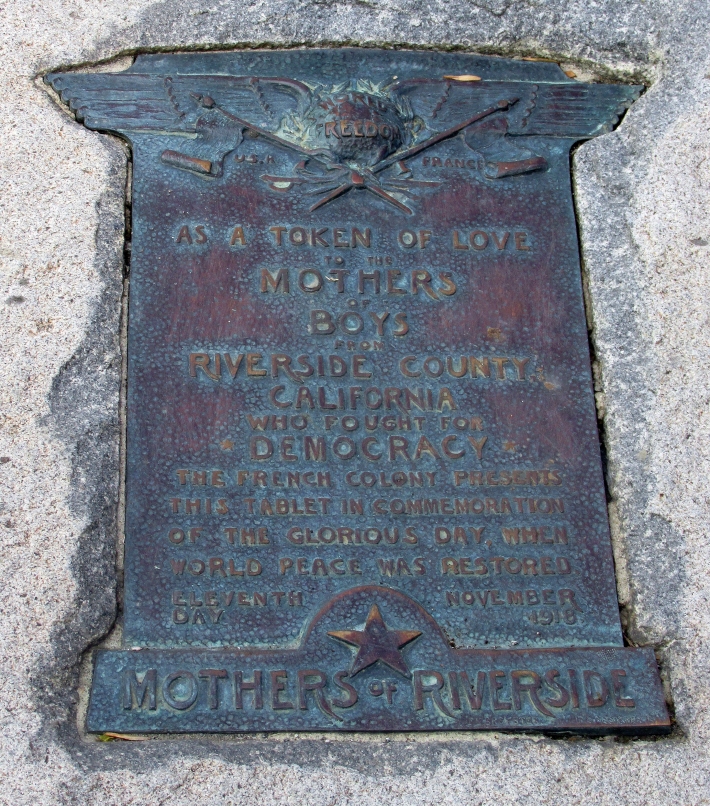Riverside's Historic Casa Blanca Neighborhood to Host 116th Cinco de Mayo Celebration
Annual cultural event returns April 26 to Villegas Park with entertainment, food, and family activities.
In 1919, Riversiders from 'the French colony' dedicated a tablet in White Park to honor the mothers of soldiers who served in World War I

A few days after the 1918 Armistice, a group of Riverside citizens of French ancestry met at Polytechnic High School to discuss a plan to honor approximately 1,000 Riverside women, the mothers of soldiers who fought in France in World War I. The idea for this monument came from Emil Mauler-Hinnescey, a native of France who taught French at the high school.
The tablet was planned to be unveiled Thanksgiving Day morning, with various guests and local dignitaries speaking, at White Park, Riverside’s oldest park, located on Market Street within the original mile square of the city. The tablet was designed by another Poly High teacher, Frederick. E. Brewster, a design instructor and a graduate of a famous Paris art school.
The bronze tablet was engraved with the words:
MOTHERS OF RIVERSIDE
AS A TOKEN OF LOVE TO THE MOTHERS OF BOYS FROM RIVERSIDE COUNTY,
CALIFORNIA, WHO FOUGHT FOR DEMOCRACY, THE FRENCH COLONY PRESENTS
THIS TABLET IN COMMEMORATION OF THE GLORIOUS DAY, WHEN WORLD
PEACE WAS RESTORED
ELEVENTH DAY, NOVEMBER 1918

The tablet was mounted on a suitable granite boulder found in the foothills near Elsinore, and placed in White Park the Saturday before Thanksgiving in anticipation of the ceremony. However, that Monday the Riverside Board of Health unanimously re-instituted an indefinite prohibition of all gatherings, both indoors and outdoors, due to a resurgence of the 1918 influenza pandemic.
After the bronze tablet arrived in Riverside, it was placed on display in a window of the George N. Reynolds Department Store at the northeast corner of Ninth and Main Streets. This Riverside landmark, according to Joan Hall in Riverside’s Invisible Past, was a three-story building that when completed in the late 1800s was the largest department store in Southern California. Here Riverside residents could view the tablet until the pandemic ban was lifted and the memorial could be dedicated. Though master stonecutter A.N. Teffts placed the tablet at White Park on December 24, 1918, it was not until April 9, 1919, that the ceremony was finally held.

That day a group of dignitaries mounted a raised platform decorated with the flags of France and the United States for the occasion. The ceremony began with the assembly singing “America,” led by Miss Rita Gould, a local vocal soloist and teacher, accompanied by the Polytechnic high school band under the direction of Gustav Hilverkus.
Mayor Horace Porter invited the members of Riverside’s French-American colony to gather around the monument they had gifted the city, and the French consul from Los Angeles, M. Louis Sentous, thanked the mothers of Riverside and the people of the United States for their contributions to the war. Mayor Porter invited Mrs. J. R. King, president of the Mothers of Democracy, to come forward and accept the tablet on behalf of the mothers of Riverside. Miss Gould, again accompanied by the Polytechnic high school band, sang “La Marseillaise,” the French national anthem.
A surprise reunion took place in the middle of the ceremony, as witnessed by a reporter from the Riverside Daily Press. The reporter described the event:
Standing at the edge of the crowd, clad in her Sunday black taffeta, stood a middle-aged woman, plump and motherly, with a kindly face. She was one of those very mothers to whom the bronze tablet was dedicated. In the middle of the exercises, the reporter heard a little strangled poignant cry, hardly more than a breath, and turning, saw the mother in the arms of her brawny soldier son, rocking back and forth in his tremendous bear hug. John M. Kenna had come home from Camp Hancock, N.J., keeping his arrival a secret from his mother. Rumor had reached Riverside that the lad had died of influenza, and though Mrs. Kenna knew her boy was safe, still his coming must have been like that of one risen from the dead. (Riverside Daily Press, April 10, 1919, page 2).
The dedication ceremony closed with the singing of the “Star-Spangled Banner.”
This Memorial Day weekend one might consider making a trip to downtown Riverside and visiting historic White Park. There, shortly after entering the park off of Market Street, you will find the monumental tablet dedicated in 1919 to the “Mothers of Boys.”
Let us email you Riverside's news and events every Sunday, Monday, Wednesday, and Friday morning. For free